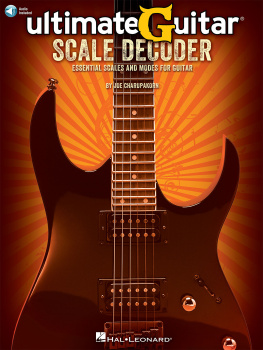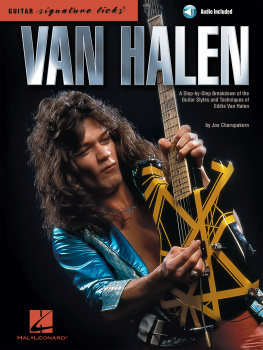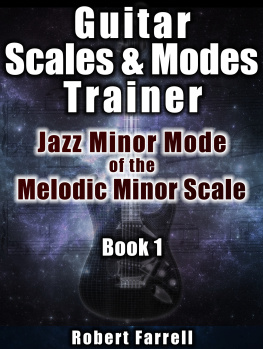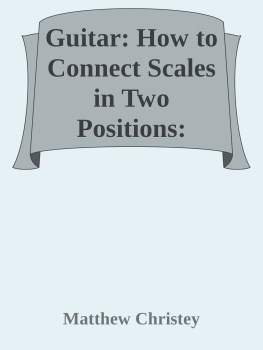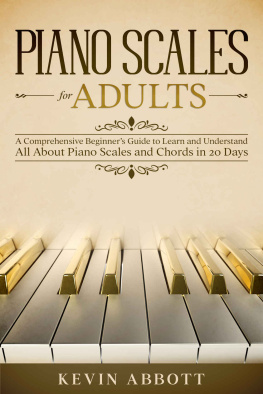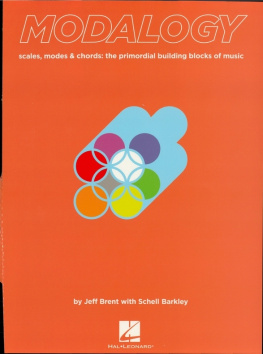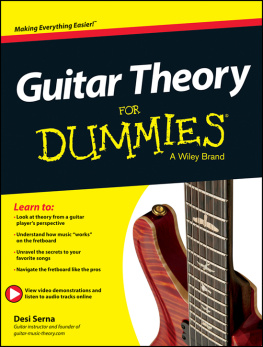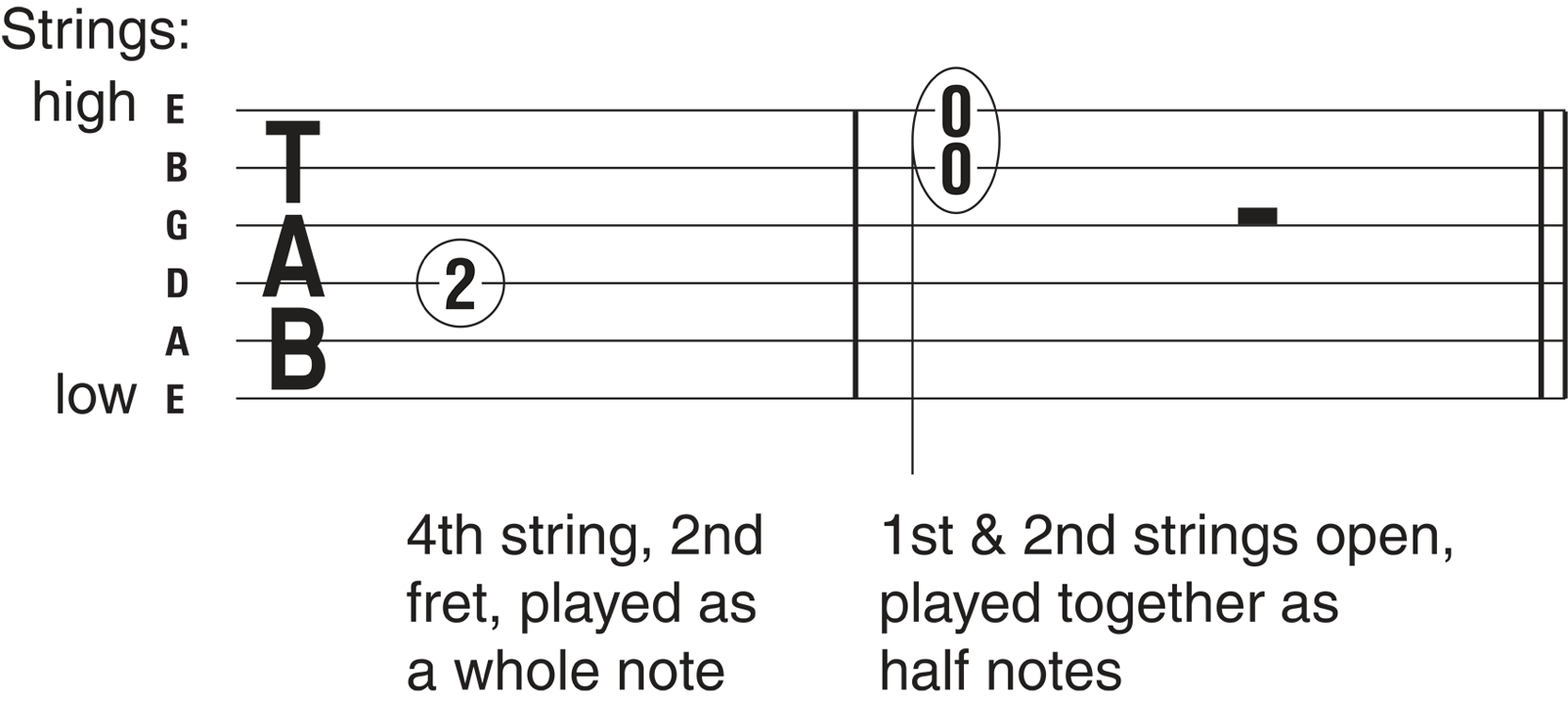7777 W. Bluemound Rd. P.O. Box 13819 Milwaukee, WI 53213
For all works contained herein:
Unauthorized copying, arranging, adapting, recording, Internet posting,
public performance, or other distribution of the printed or recorded music
in this publication is an infringement of copyright.
Infringers are liable under the law.
Visit Hal Leonard Online at
www.halleonard.com
Table of Contents
INTRODUCTION
The is aimed at guitarists who are mystified by scales and modes. While there are many scale books available, a common roadblock is that most of these books just list every possible scaleuseful or notlike a dictionary lists every word. With that method, its easy to become intimidated and frustrated because your energy is spent trying to memorize scales and fingerings that you might not really need. Instead, you could be focusing on the important scales used most often by the masters. The displays only the most essential scales that youll need to have under your fingers in the most practical and useful fingerings, along with an easy-to-understand primer on how to create scales. Additionally, each of the scales presented is accompanied by a musical example on the included audio so you can actually hear what a specific scale or mode sounds like in a typical context.
While electric guitarists have created some of the most exciting music in history, the majority of them dont have the same command of scales as classical or jazz instrumentalists do because many guitarists learn from tabs or by rotewatching and imitating a peer or from watching a video. If you fall into that category and can already play your favorite songs, or if you already know some scales but want to expand your repertoire, the material in this book will add another dimension to your playing and writing. With a fundamental knowledge of the most common scales and a glimpse at how theyre conventionally used, youll soon be improvising your own solos or writing your own riffs without feeling like youre in the dark.
ABOUT THE AUTHOR
New York City native Joe Charupakorn is a guitarist, editor, and best-selling author. He has written more than 20 instructional books for Hal Leonard Corporation including Signature Licks: The Best of Yngwie Malmsteen, Signature Licks: Mike Stern, Jazz Improv Basics, and Classic Rock Heroes. His books are available worldwide and have been translated into many languages. Visit him on the Web at joecharupakorn.com.
ABOUT THE RECORDING
Guitars: Joe Charupakorn
Bass: Tom McGirr
Keyboards: Warren Wiegratz
Drums: Scott Schroedl
READING TAB
Tab is used for the actual musical examples and no reading of music notation is required to get the most out of this book. Here is an explanation of how to read tab if youre not already familiar.
Tablature graphically represents the guitar fingerboard. Each horizontal line represents a string, and each number represents a fret. Rhythmic values are shown using ovals, stems, and dots.
THE CHROMATIC SCALE
A consists of every available note used in Western music. Here is the chromatic scale starting on C:
C C A /D D D D A /E D E F F A /G D G G A /A D A A A /B D B C
In this spelling of the chromatic scale youll notice that some notes have slashes and an alternate name. For example: C A /D D or D A /E D . What that means is C A is the same note as Db, and D A is the same note as E D . Any note with an accidentala sharp or flatcan be spelled either as a sharp or flat version of the note depending on its context. In this book, well list the most commonly encountered spellings but be aware that they are often interchangeable.
The chromatic scale can start on any note. Lets try it on the guitar. If you play every note on the 6th string starting from the open string and going up fret-by-fret to the 12th fret, youll have played the chromatic scale from E to E. After the 12th fret, the chromatic scale starts over again.
Lets try this on the 5th string. Here the chromatic scale is played starting on A. You should notice that other than the starting point, all of the chromatic scales weve looked at contain exactly the same notes.
HALF STEPS AND WHOLE STEPS
and are terms used to describe the distance between two closely located notes. A half step is the distance from one note to the very next note. On the guitar, a half step is a one-fret distance. It doesnt matter whether you are going from one fretted note to another or from an open string to a fretted note or vice versa. It also doesnt matter whether one note is natural and the next one is also natural or has an accidentalsharp or flat. The actual distance is what were measuring. For example: C to C A /D D is a half step, as is E to F.
A whole step is a distance of two notes in the chromatic scale. On the guitar, this is a two-fret distance and as with half stepsor any interval for that matterit doesnt matter whether one or both notes are fretted, or whether one note is natural and the other one is also natural or has an accidental. For example: D to E is a whole step as is A A /B D to C.
CONSTRUCTING THE MAJOR SCALE
The also referred to as the Ionian modeis the foundation from which all the common scales and modes youll hear in Western music are derived. To create a major scale, apply the following formula to the chromatic scale:
WholeWhole1/2 WholeWholeWhole1/2
Starting on C we get:
Lets create a major scale starting on E and see how it relates to the guitar. This example is played exclusively on the 6th string.
E Major Scale
Heres the same idea starting on A, this time using the open 5th string of the guitar.
A Major Scale
If you did this starting from every open string, youll notice that all the major scales have exactly the same shape, in terms of fret location. This tells us that, other than the starting note, every major scale is exactly the same in terms of note relationships. Heres a C major scale played only on the 2nd string, starting from the 1st fret. Notice that the distance between the notes is exactly the same as the E and A major scales we just looked at.

